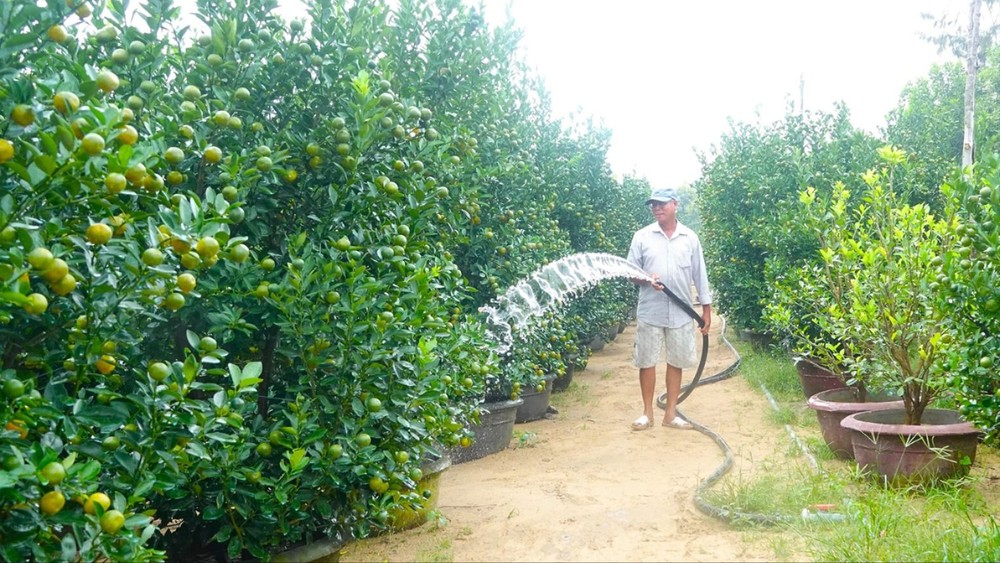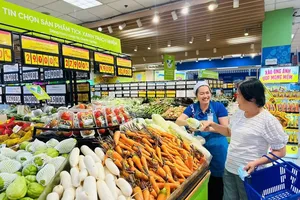
According to many farmers, the beauty of the flowers is significantly influenced by the weather. The panorama of the Tet ornamental flower market reveals contrasting colors.
Nervously anticipating the weather
Currently, peach blossom cultivators in Nhat Tan (Tay Ho District) and La Ca Village (Ha Dong district) of Hanoi are busy plucking peach blossom leaves to ensure they are ready for the Tet market. According to Tran Thi Xuan, a peach blossom grower in La Ca village, the price of peach blossoms varies from year to year, depending on the weather. Warm weather leads to early blooming, while colder conditions result in later blooms.
"If the peach blossoms bloom at the right time, each branch can be priced between VND200,000 and VND300,000. If they bloom early, the selling price is lower. Everything is relying on the weather," Xuan remarked.
Traveling West from Hanoi, flower farmers in Tay Tuu Ward (Bac Tu Liem District) are actively tending to various flower varieties, especially chrysanthemums, dahlia, and roses, in preparation for the Tet market in the Northern region and Hanoi.
Nguyen Thien Dinh, a local flower farmer, said that flower seedlings are more expensive this year compared to previous years. Specifically, the dahlia seedlings cost VND3,000 each. If they thrive during the Tet season, each plant can produce three branches, and each branch can be sold for VND10,000-VND50,000.
"If the weather is warm, flowers bloom early, and there will be many flowers during the offerings to the Kitchen Gods. Even, there a possibility that flowers may become scarce near the Lunar New Year, and prices will be high," Dinh explained.
In these days, the unusual cold and rain are causing worry among flower and ornamental plant farmers in the Central region due to the unpredictable weather. This year, the entire Cam Ha Commune in Hoi An City is cultivating approximately 45,000 kumquat pots for the Tet market with around 500 specialized farming households.
Nguyen Thien Nhan's family in Ben Tre Hamlet, Cam Ha Commune, Hoi An City, Quang Nam Province, has grown 800 kumquat pots in preparation for the Tet market. "Traders have already placed orders for up to 95 percent of my output, and currently, I only have 40 kumquat pots left. Profit and loss have not been calculated yet, while the prices of fertilizers and antifungal drugs have all doubled compared to before," shared Nhan.
These days, garden owners are consistently tending and meticulously pruning to produce the most exquisite kumquat pots. According to Nghiem Thi Phuong, a farmer in Cam Ha Commune, Hoi An City, the abundant rainfall this year has made garden care quite demanding. The flower market is also less vibrant because after the Covid-19 pandemic, most people tend to tighten their expenses.
In Da Nang City, farmers in the Duong Son flower village (Hoa Vang District, Da Nang City) are bustling with caring for and shaping Tet flowers. Having been involved in the cultivation of chrysanthemums for many years, Vo Thi Tuoi, a 69-year-old farmers in Hoa Chau Commune, has cultivated around 1,000 pots of chrysanthemums this year. "The chrysanthemums are currently in the growing stage. It is anticipated that by the end of the 11th month in the lunar calendar, the chrysanthemums will begin to bud," shared Tuoi.
Mr. Ly Phuoc Dang, Head of the Duong Son Flower Production Cooperative, informed that the entire region has approximately 4.5 hectares with 19 households involving in chrysanthemum cultivation. Due to its ease of care and consistent demand, chrysanthemums remain the primary flower variety, chosen by numerous households for cultivation and sale during the Tet season. This year, local farmers plan to grow 14,000 pots of chrysanthemums, and additional varieties like marigold, gerbera, and petunia will continue to be planted. Furthermore, Mr. Dang and some households are conducting trials to cultivate hollyhock.
"This year, the abundant rainfall has made plant care more challenging, demanding farmers to exert extra effort. Production costs, including material prices, seedlings, and pots, have risen by more than 10 percent compared to the previous year. Particularly, the cost of fertilizers at the beginning of the season has experienced a significant increase of 30-40 percent," explained Mr. Dang.
Full purchases of Buddha's hand fruit orchards
Buddha's hand fruit is renowned for its pleasant fragrance and holds special meaning during the Tet holiday for the Vietnamese people. Numerous traders have made full purchases of Buddha's hand fruit orchards grown by farmers in Dac So Commune, Hoai Duc District, Hanoi, in nearby regions, spanning hundreds of hectares.
Previously, Buddha's hand fruit was predominantly cultivated in Dac So and Yen So communes, Hoai Duc District. Over the years, due to impoverished soil, this particular plant is no longer suitable for the area. Over the past many years, those engaged in Buddha's hand fruit cultivation have had to seek rented land in adjacent areas such as Phuc Tho and Dan Phuong districts.
Nguyen Thi Ngat, one of the few remaining cultivators of Buddha's hand fruit in Yen So Commune, shared, "From now until the 20th of the twelfth lunar month, I will be harvesting ripe Buddha's hand fruit for retail sale. Currently, Buddha's hand fruit is priced at VND18,000-20,000 per kg, and for beautiful fruits, the prices range from VND50,000 to over VND100,000 per kg."
Close by is the Buddha's hand fruit orchard of Nguyen Phu Phuong. His 200 Buddha's hand fruit trees are in the mature fruiting stage. "Buddha's hand fruit is a demanding plant, particularly about soil and fertilizers, making it challenging to care for. This year, it has fetched high prices, with some fruits selling for tens of thousands of Vietnamese dong and beautiful ones commanding prices in the millions. Residents in Dac So and Yen So communes often sell their entire orchards to traders, with each tree fetching prices ranging from VND1.4 million to VND1.8 million, sold about two months prior to Tet," Phuong said.
About 20 kilometers away is the Buddha's hand fruit orchard with 500 trees owned by Nguyen Phu Thang, a farmer in Dac So Commune, Hoai Duc District, who has rented land for cultivation in Trung Chau A Commune in Dan Phuong District since 2017. Thang mentioned that at this time, very few orchard owners engage in retail sales due to low prices and numerous risks; typically, they sell the entire orchard to traders. Around the 25th of the twelfth lunar month, traders complete the harvest and return the orchard.
"I own two orchards, comprising over 500 Buddha's hand trees. After deducting expenses for fertilizer and care, I anticipate earning approximately VND300 million. Currently, local residents retail the fruit to consumers at VND50,000 per fruit, with outstanding ones fetching around VND600,000 each. This year appears to be a successful season," Thang assessed.
Scaling down production to preserve brand reputation
The upcoming Tet flower market in 2024 is expected to face uncertainty due to economic difficulties. Flower farmers in Da Lat and nearby areas in Lam Dong Province are carefully taking care of their flowers but with a sense of caution. In order to mitigate any risks associated with this year's purchasing power, many flower villages have intentionally reduced both the size of their cultivation areas and the overall production volume.
Tran Minh Son's family, residing in Van Thanh flower village, Ward 5, Da Lat City, invested over VND300 million to cultivate around 20,000 lily bulbs on an area of nearly 1,000 square meters, down more than two-thirds compared to the previous year. Despite the favorable development of the flowers, Son remains apprehensive.
'The weather has been unusually unpredictable, with prolonged warm and sunny days causing rapid plant growth. However, with the temperature dropping, it becomes challenging to precisely time the flowering period. Lily cultivation is delicate, and a deviation of just a few days in flower blooming can result in the failure of the entire crop. Therefore, my family decided to reduce the cultivation area and, instead, intersperse it with other flowers like gerbera and bluebell,” Son said.
Traditional flower villages in Da Lat have seen a considerable reduction in the cultivation area for some typical flowers of the region, such as lilies and boat orchids, this year. In some areas, the planting area of lilies is only around 50 percent of what it was in previous Tet flower seasons. Instead, local residents have opted for intercropping with other flowers like bluebell, carnation, sea lavender, gerbera, and chrysanthemums. This strategy helps minimize risks since the investment in these alternative flowers is not substantial, and interventions are more convenient compared to lily varieties.
In Hiep An Commune, Duc Trong District, recognized as the “granary” for gladiolus flowers in Lam Dong Province, local flower cultivators have grown over 100 hectares of various gladiolus varieties. The weather is favorable, and gladiolus harvesting in Hiep An and nearby regions has initiated. The peak harvest is anticipated around the 23rd of the twelfth lunar month, instilling hope among local farmers for a profitable flower season.
Nguyen Van Chau, Deputy Director of the Department of Agriculture and Rural Development in Lam Dong Province, observes that the Tet market presents numerous opportunities for farmers. Nevertheless, given the challenging economic circumstances, farmers must concentrate on elevating product quality to enhance competitiveness and uphold the esteemed brand of Da Lat flowers. The department is actively collaborating with the Da Lat Flower Association to conduct surveys in flower production areas, offer recommendations, and assess the market to assist local residents in achieving a more prosperous flower season.

Customized production
In the face of challenging economic conditions, many flower growers in the Cho Lach ornamental flower village in Ben Tre Province are adopting a cautious approach by cultivating a limited quantity to avert risks. Chrysanthemums, a traditional flower with significant demand, typically experiences high demand during Tet. However, this year, most growers in Tan Thieng Commune (Cho Lach District) are growing flowers exclusively based on pre-orders. Nguyen Van Tam, a local grower in Tan Thieng, noted that in previous years, his family would cultivate over 4,000 pots of chrysanthemums. By this time, traders would usually have placed deposits to secure the entire harvest. However, he has only managed to sell half of the production this year.
The strength of the Cho Lach ornamental flower village is evident in its focus on producing various bonsai and animal-shaped ornamental plants, which are the best-sellers, providing significant income to local growers.
Cong, the owner of the Nam Cong ornamental plant production facility, revealed that, in light of the Year of the Dragon, his establishment is rushing to craft dragon-themed ornamental plants to meet the demands of the Tet market. According to Cong, ornamental plants depicting mythical creatures are usually hard to find customers due to their higher prices, ranging from VND15-50 million per pot. Despite the economic challenges this year, there is a stable customer base, mainly comprised of loyal customers from companies, businesses, and State agencies in Hanoi, Ho Chi Minh City, Can Tho, and Kien Giang. Currently, 300 pots of dragon-shaped ornamental plants at the Nam Cong facility have already been reserved by customers.
These days, in the renowned Sa Dec flower village in Dong Thap Province, numerous gardeners are focusing on nurturing chrysanthemums, cosmos, and French roses. Beyond contributing to the Tet market, local cultivators are also growing flowers for the upcoming Flower Festival. Hence, the diversity and quantity of flowers in Sa Dec have surpassed previous years, with an array of species originating from countries such as South Korea and the Netherlands.
Ms. Vo Thi Binh, Vice Chairwoman of the People's Committee of Sa Dec City, reveals that the area boasts over 4,000 households engaged in flower cultivation. Among these, 200 establishments are actively involved in ornamental flower production and trade, resulting in an average income of VND150 million per person annually and a total production value exceeding VND3 trillion per year. For the upcoming Tet season, the total area allocated for ornamental flower cultivation in the city has expanded from 650 hectares to 950 hectares, showcasing over 2,000 distinct species of ornamental flowers. The primary concentration of cultivation is observed in Tan Quy Dong Ward, Tan Khanh Dong Commune, Tan Quy Tay Commune, and An Hoa Ward.
According to the Da Lat Flower Association, for the Lunar New Year 2024, orchid farms and cultivation businesses are projected to supply the market with approximately 3 million branches of various orchid species. Enterprises with substantial moth orchid production capacity, such as Bonnie Farm Truong Hoang, Ysa Orchid, and Minh Hue, have proactively prepared a significant quantity of moth orchid flower stems for the upcoming Tet season.
Mr. Nguyen Ngoc Thanh, Vice Chairman of the Da Lat Flower Association, mentioned that in addition to traditional flower varieties for Tet, some units are concentrating on developing high-quality flower varieties such as dancing lady orchids or those dyed with organic compounds like chrysanthemums and moth orchids to introduce a diverse range of products to the market.
According to Mr. Doan Van Bao, Deputy Head of the Agriculture Department under the Department of Agriculture and Rural Development of Da Nang City, Tet flowers is the main production season for flower growers in the suburban areas of Da Nang City. However, storms and rains often lead to some diseases affecting the plants.
To address these challenges, the Agriculture Department has provided guidance to localities and flower-producing regions on implementing measures for pest and disease control. Officials from the department regularly visit production areas to provide guidance and promptly address any issues, ensuring that these incidents do not adversely affect the cultivation activities of farmers.
























